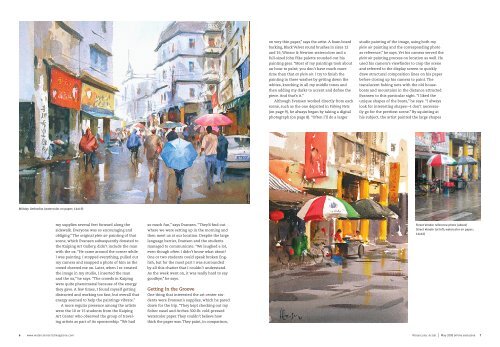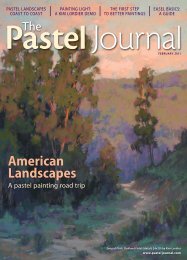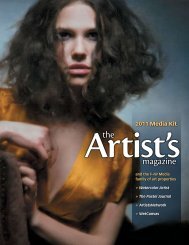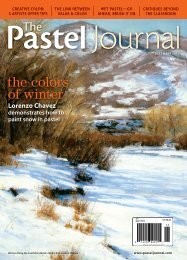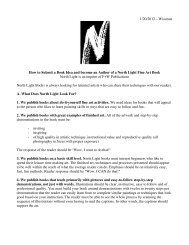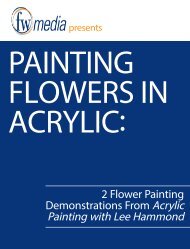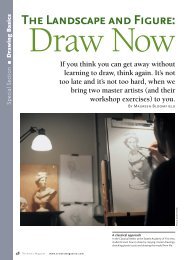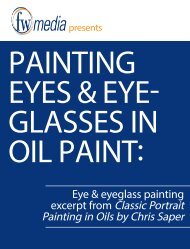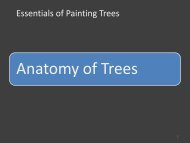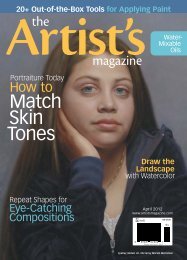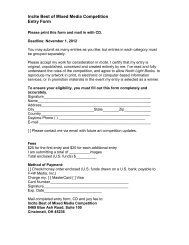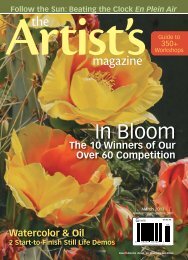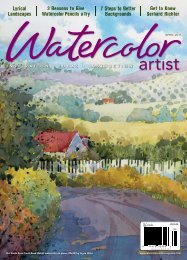Create successful ePaper yourself
Turn your PDF publications into a flip-book with our unique Google optimized e-Paper software.
on very thin paper,” says the artist. A foam boardbacking, Black Velvet round brushes in sizes 12and 16, Winsor & Newton watercolors and afull-sized John Pike palette rounded out hispainting gear. “Most of my paintings took aboutan hour to paint; you don’t have much moretime than that en plein air. I try to finish thepainting in three washes by getting down thewhites, knocking in all my middle tones andthen adding my darks to accent and define thepiece. And that’s it.”Although <strong>Evansen</strong> worked directly from eachscene, such as the one depicted in Fishing Nets(on page 9), he always began by taking a digitalphotograph (on page 8). “Often I’ll do a largerstudio painting of the image, using both myplein air painting and the corresponding photoas reference,” he says. Yet his camera served theplein air painting process on location as well. Heused his camera’s viewfinder to crop the sceneand referred to the display screen to quicklydraw structural composition lines on his paperbefore closing up his camera to paint. Thetranslucent fishing nets with the old houseboatsand mountains in the distance attracted<strong>Evansen</strong> to this particular sight. “I liked theunique shapes of the boats,” he says. “I alwayslook for interesting shapes—I don’t necessarilygo for the prettiest scene.” By squinting athis subject, the artist painted the large shapesMidday Umbrellas (watercolor on paper; 14x19)my supplies several feet forward along thesidewalk. Everyone was so encouraging andobliging.” The original plein air painting of thatscene, which <strong>Evansen</strong> subsequently donated tothe Kaiping Art Gallery, didn’t include the manwith the ox. “He came around the corner whileI was painting. I stopped everything, pulled outmy camera and snapped a photo of him as thecrowd cheered me on. Later, when I re-createdthe image in my studio, I inserted the manand the ox,” he says. “The crowds in Kaipingwere quite phenomenal because of the energythey gave. A few times, I found myself gettingdistracted and working too fast, but overall thatenergy seemed to help the paintings vibrate.”A more regular presence among the artistswere the 10 or 15 students from the KaipingArt Center who observed the group of travelingartists as part of its sponsorship. “We hadso much fun,” says <strong>Evansen</strong>. “They’d find outwhere we were setting up in the morning andthen meet us at our location. Despite the largelanguage barrier, <strong>Evansen</strong> and the studentsmanaged to communicate. “We laughed a lot,even though often I didn’t know what about!One or two students could speak broken English,but for the most part I was surroundedby all this chatter that I couldn’t understand.As the week went on, it was really hard to saygoodbye,” he says.Getting In the GrooveOne thing that interested the art center studentswere <strong>Evansen</strong>’s supplies, which he pareddown for the trip. “They kept checking out mySoltec easel and Arches 300-lb. cold-pressedwatercolor paper. They couldn’t believe howthick the paper was. They paint, in comparison,Street Vendor reference photo (above)Street Vendor (at left; watercolor on paper;14x10)www.watercolorartistmagazine.comwatercolor Artist | May 2008 online exclusive


